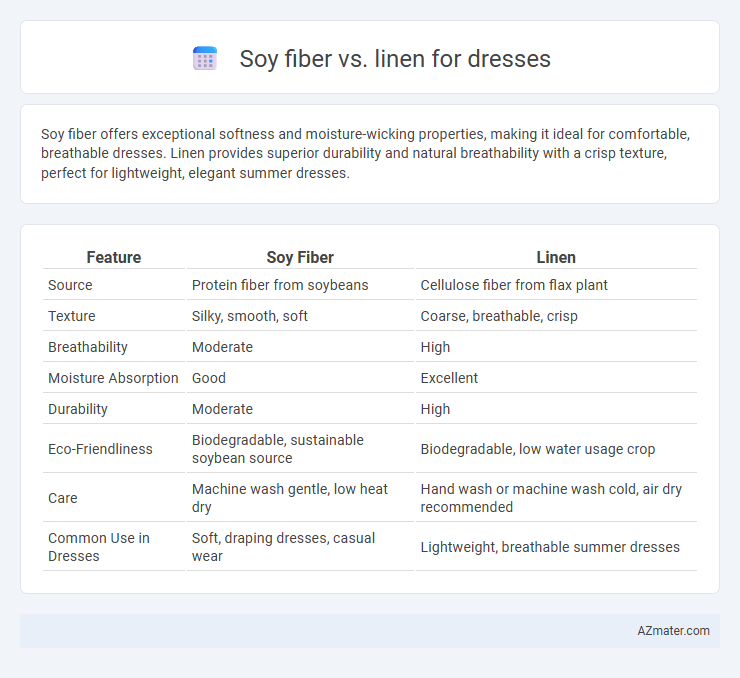Soy fiber offers exceptional softness and moisture-wicking properties, making it ideal for comfortable, breathable dresses. Linen provides superior durability and natural breathability with a crisp texture, perfect for lightweight, elegant summer dresses.
Table of Comparison
| Feature | Soy Fiber | Linen |
|---|---|---|
| Source | Protein fiber from soybeans | Cellulose fiber from flax plant |
| Texture | Silky, smooth, soft | Coarse, breathable, crisp |
| Breathability | Moderate | High |
| Moisture Absorption | Good | Excellent |
| Durability | Moderate | High |
| Eco-Friendliness | Biodegradable, sustainable soybean source | Biodegradable, low water usage crop |
| Care | Machine wash gentle, low heat dry | Hand wash or machine wash cold, air dry recommended |
| Common Use in Dresses | Soft, draping dresses, casual wear | Lightweight, breathable summer dresses |
Introduction to Soy Fiber and Linen
Soy fiber is a sustainable, biodegradable textile derived from the byproducts of soybean processing, offering a smooth texture and excellent moisture absorption ideal for dress fabrics. Linen, made from the flax plant, is renowned for its durability, breathability, and natural luster, making it a popular choice for lightweight, comfortable dresses. Both fibers provide eco-friendly alternatives to conventional materials, with soy fiber excelling in softness and linen prized for its strength and coolness.
Origin and Production Processes
Soy fiber is derived from the byproducts of soybean processing, utilizing a sustainable method that transforms soybean protein into a soft, biodegradable textile through an extrusion process. Linen originates from the flax plant, with fibers extracted by retting and scutching, followed by spinning to create a durable, natural fabric known for breathability. The production of soy fiber involves a modern, eco-friendly technique emphasizing waste reduction, while linen relies on traditional agricultural and manual labor processes rooted in centuries-old craftsmanship.
Environmental Impact Comparison
Soy fiber and linen differ significantly in environmental impact, with linen generally recognized for its sustainability due to flax plants requiring minimal water and pesticides for cultivation. Soy fiber, derived from soybean protein, offers a renewable alternative but involves more energy-intensive processing and potential use of chemicals in fiber extraction. Linen's biodegradability and lower carbon footprint compared to soy fiber make it a preferable choice for eco-conscious dressmakers.
Texture and Comfort Differences
Soy fiber offers a silky, smooth texture with a natural sheen, enhancing the luxurious feel of dresses while promoting breathability and moisture-wicking properties for superior comfort. Linen, characterized by its crisp, slightly coarse texture, provides excellent airflow and a lightweight structure, making it ideal for cooling in warm weather but with less softness initially. The choice between soy fiber and linen for dresses hinges on the preference for a silky, soft fabric versus a textured, breathable material that softens with wear.
Breathability and Moisture Wicking
Soy fiber exhibits excellent breathability and moisture-wicking properties, making it ideal for dresses worn in warm climates. Linen, made from flax fibers, is renowned for its superior airflow and natural ability to absorb and quickly evaporate moisture, ensuring comfort during hot weather. Both fabrics outperform many synthetic alternatives in keeping the skin dry and cool but linen tends to offer a more durable and crisp texture.
Durability and Longevity
Soy fiber fabric offers moderate durability with a smooth texture, but it tends to wear out faster than linen when exposed to frequent washing and abrasion. Linen is renowned for its exceptional strength and longevity, often lasting for years without significant deterioration, making it ideal for dresses subjected to regular use. The natural fibers in linen also enhance breathability while maintaining structural integrity, ensuring sustained durability over time.
Color Retention and Dye Affinity
Soy fiber offers superior color retention compared to linen, maintaining vibrant hues even after multiple washes due to its smooth, protein-based structure that binds dye molecules effectively. Linen, while breathable and durable, tends to fade faster because its cellulose fibers have lower dye affinity, causing colors to wash out more quickly over time. Choosing soy fiber for dress fabrics ensures longer-lasting, richer colors, making it ideal for garments requiring vivid and enduring dye performance.
Care and Maintenance Requirements
Soy fiber dresses require gentle washing in cold water and air drying to maintain fabric softness and prevent shrinkage, with minimal ironing needed due to natural wrinkle resistance. Linen dresses demand more intensive care, including hand washing or machine washing on a delicate cycle, frequent ironing at medium to high heat to smooth wrinkles, and careful drying to avoid fabric stiffness and shrinkage. Both fibers benefit from avoiding bleach and storing in breathable conditions, but linen typically requires more frequent maintenance to preserve its crisp texture.
Price and Market Availability
Soy fiber dresses typically come at a moderate price point, reflecting the sustainable and eco-friendly production process, while linen dresses often range from mid to high price depending on fabric quality and brand. Market availability for soy fiber is growing but remains limited compared to linen, which is widely accessible in most fashion retail outlets due to its long-established presence. Consumers seeking budget-friendly and easily accessible options may prefer linen, whereas those prioritizing sustainability might be willing to invest more in soy fiber garments.
Conclusion: Choosing the Best Fabric for Dresses
Soy fiber offers a soft, breathable texture with excellent moisture-wicking properties, making it ideal for comfortable, lightweight dresses. Linen provides durability, a natural luster, and superior cooling capabilities, perfect for warm climates and structured designs. Selecting between soy fiber and linen depends on the desired dress style, climate suitability, and personal comfort preferences.

Infographic: Soy fiber vs Linen for Dress
 azmater.com
azmater.com